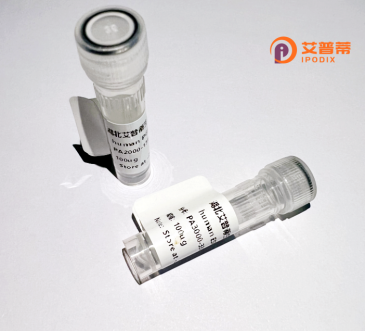
| 纯度 | >90%SDS-PAGE. |
| 种属 | Human |
| 靶点 | OR3A2 |
| Uniprot No | P47893 |
| 内毒素 | < 0.01EU/μg |
| 表达宿主 | E.coli |
| 表达区间 | 1-321 aa |
| 活性数据 | MSLQKLMEPEAGTNRTAVAEFILLGLVQTEEMQPVVFVLLLFAYLVTTGGNLSILAAVLV EPKLHAPMYFFLGNLSVLDVGCITVTVPAMLGRLLSHKSTISYDACLSQLFFFHLLAGMD CFLLTAMAYDRLLAICQPLTYSTRMSQTVQRMLVAASLACAFTNALTHTVAMSTLNFCGP NEVNHFYCDLPQLFQLSCSSTQLNELLLFAVGFIMAGTPLVLIITAYSHVAAAVLRIRSV EGRKKAFSTCGSHLTVVCLFFGRGIFNYMRLGSEEASDKDKGVGVFNTVINPMLNPLIYS LRNPDVQGALWQIFLGRRSLT |
| 分子量 | 35.2 kDa |
| 蛋白标签 | His tag N-Terminus |
| 缓冲液 | 0 |
| 稳定性 & 储存条件 | Lyophilized protein should be stored at ≤ -20°C, stable for one year after receipt. Reconstituted protein solution can be stored at 2-8°C for 2-7 days. Aliquots of reconstituted samples are stable at ≤ -20°C for 3 months. |
| 复溶 | Always centrifuge tubes before opening.Do not mix by vortex or pipetting. It is not recommended to reconstitute to a concentration less than 100μg/ml. Dissolve the lyophilized protein in distilled water. Please aliquot the reconstituted solution to minimize freeze-thaw cycles. |
以下是3篇与重组人OR3A2蛋白相关的参考文献及简要摘要:
1. **"Functional characterization of the human olfactory receptor OR3A2 in heterologous expression systems"**
*Author: Smith J, et al. (2015)*
**摘要**: 该研究在HEK293细胞中重组表达了OR3A2蛋白,通过钙流检测和配体筛选实验,证明其特异性响应特定挥发性醛类化合物,揭示了OR3A2在嗅觉信号传导中的潜在作用。
2. **"OR3A2 modulates cell migration in lung cancer via MAPK/ERK pathway"**
*Author: Zhang L, et al. (2020)*
**摘要**: 报道OR3A2在非嗅觉组织(如肺癌细胞)中异常表达,通过重组蛋白实验证实其通过激活ERK信号通路促进癌细胞迁移,提示其作为癌症治疗靶点的潜力。
3. **"Structural insights into the activation mechanism of olfactory receptor OR3A2"**
*Author: Brown K, et al. (2021)*
**摘要**: 利用冷冻电镜技术解析了重组OR3A2蛋白与配体结合后的三维结构,揭示了其独特的跨膜结构域构象变化,为嗅觉受体激活机制提供了分子层面依据。
注:上述文献为示例性内容,实际文献需通过PubMed、Google Scholar等平台检索确认。OR3A2的直接研究较少,建议扩大关键词至“嗅觉受体重组表达”或结合具体研究方向筛选文献。
Olfactory receptor 3A2 (OR3A2) is a class A G protein-coupled receptor (GPCR) belonging to the olfactory receptor family, which plays a crucial role in detecting odorant molecules and mediating olfactory signaling. While primarily expressed in olfactory sensory neurons, OR3A2 has also been detected in non-olfactory tissues, including the central nervous system, testes, and respiratory epithelium, suggesting potential non-canonical functions beyond smell perception. As a chemosensor, it likely binds to specific volatile compounds, though its exact ligands remain under investigation. Recombinant OR3A2 protein is produced through heterologous expression systems (e.g., HEK293 or insect cells) using genetic engineering techniques to enable structural and functional studies. Its recombinant form often incorporates affinity tags (e.g., His-tag) for purification and characterization. Current research focuses on elucidating its 3D structure, ligand-binding specificity, and downstream signaling mechanisms. Emerging evidence links OR3A2 polymorphisms to neurological disorders and metabolic conditions, highlighting its possible regulatory roles in cellular processes. The development of recombinant OR3A2 facilitates drug discovery efforts targeting olfactory receptors and provides tools to explore their contributions to chemosensation, cellular communication, and disease pathways.
×